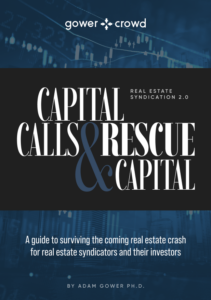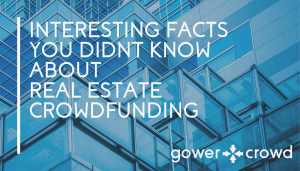Your Ultimate Guide to Real Estate Waterfalls
When investing in a real estate project as a passive partner, cash distributions are calculated and made using what is called a ‘waterfall,’ most of which are structured according to reasonably uniform standards, and some of which are more creative.
Real estate syndications use these ‘waterfalls’ to structure and compensate principals and investors, and these are seldom altered once a developer creates a structure that works for them. There are, however, a vast array of ways in which waterfalls are designed and this article examines the most common, as well as looking at some of the most complex.
Simply stated, a waterfall describes the way cash available for distribution and profits in a project cascades through a series of calculations to make payments to the developer and their investors in a pre-arranged hierarchical fashion.
The most common tools used to define how revenue and profit splits are made include the preferred return and the internal rate of return. These can be used in unison to create different breakpoints where, as certain return hurdles are achieved by the sponsor as measured by the IRR, the proportional share of profits will be adjusted.
Related: How to Syndicate a Real Estate Deal
What is a “waterfall” when it comes to cash flow distributions?
A real estate waterfall is used to describe how different investors are repaid their investment through a share of the cash flow distributions. Think of a waterfall in which water flows from the top before reaching another level below, at which point it pools and then flows to the next level below it, and so on.
A real estate waterfall is similar. Those slated to earn a preferred return will be repaid first, with other investors repaid later. As we’ll describe, these waterfalls can take many forms and can be quite complex. There are usually certain benchmarks that need to be met before the deal sponsor can start earning its share of the cash flow distributions, which keeps the sponsor motivated and ensures that interests are aligned through the duration of the project.
What Are The Common Waterfall Components
Equity waterfalls are one of the most difficult concepts for real estate investors to truly grasp. This is partially because of the various ways in which waterfalls can be structured. The structure largely depends on the nature of the deal, including the investment timeline and number of investors involved. In the sections below, we discuss the most common waterfall components.
For more great insights on real estate check out the GowerCrowd Blog
Return hurdle
In commercial real estate, the term “return hurdle” is used to define the rate of return that must be achieved before cash flow distributions can flow on to the next tier of investors in the equity waterfall. Most waterfalls have multiple return hurdles. Typically, the return hurdles are based on achieving a predefined internal rate of return (IRR—more on this below) or equity multiple.
Return hurdles are especially important because they are what trigger the disproportionate distribution of profits. They are structured to incentivize the deal sponsor to manage the project as efficiently and profitably as possible. The higher the return the deal produces, the greater share of the profits the sponsor stands to make relative to their initial investment. For example, let’s say a deal is expected to achieve an internal rate of return of 8%. Below that hurdle, the cash flows are split 80/20 among investors (80%) and the sponsor (20%). Above that hurdle, the split shifts to 70/30, which provides the sponsor with a greater share of the profits.
Preferred Return
Waterfalls also use the preferred return. Also known as "the pref," it refers to the first claim on profits earned by investors until a specified target return has been completed. It is paid rather like a bank pays interest with two major distinctions; one, it can be paid either current or accrued whereas a bank usually pays only current, and two, it is not guaranteed like a bank but rather investors are the first to get paid, in the form of the pref. They will receive a distribution of profits provided there is profit to be distributed. After the preferred return hurdle has been met, any excess profits are split between the parties as stipulated in the terms of the deal. The makeup of preferred investors varies from deal to deal.
Related: The Waterfall In Real Estate Syndications - White Paper
Lookback Provision
Whenever an equity waterfall pays out cash flow distributions prior to the disposition of the asset, the deal will typically contain what’s known as a “lookback provision.” Essentially, this stipulates that if the investor does not receive his anticipated (pre-agreed upon) rate of return, the sponsor will be required to give up a portion of their already distributed profits to fill that gap. In other words, the sponsor is obligated to provide investors with the full amount of the predetermined return—something that is often done through the sponsor’s proceeds of the sale of the asset. This is another provision that is intended to motivate the sponsor to perform.
Catch-up Provision
The catch-up provision requires that investors get 100% of profit distributions until the agreed-upon predetermined rate of return has been achieved. After the investor reaches the required return levels, 100% of the profits will go to the sponsor until they have received the same return as investors.
This provision is a variation of the lookback provision and is used for the same purpose. The major difference between the two is that with the lookback provision, the investor is required to go back to the sponsor at deal's end and get them to write a check. The catch-up provision provides the investor with 100% of the profits until the required return is met, and only then does the sponsor receive a distribution.
Most sponsors prefer the lookback provision, mostly because they get to use that money in the short term, even if they will eventually pay it out to investors. Conversely, investors prefer the catch-up provision because they get paid first, and they don't need to track down the sponsor to get paid in the event a deal does not go entirely as projected.
How Waterfall Breakpoints are Calculated
According to Investor Management Services (IMS), the industry-leading investment management technology company for commercial real estate, commonly seen waterfalls offer an 8 percent preferred return with a 90-10 or 80-20 split of the profits to the investors and developers respectively.
There may then be a break where the split changes to 70-30 or 60-40 once investors have received a certain internal rate of return (IRR), perhaps a 12 percent or 15 percent IRR.
The important point here is that the most commonly used metric used to define the breakpoint in waterfalls is the IRR.
IRR in a Waterfall Payment Model
IRR is the rate that equates future returns back to the initial equity investment. This means that it projects future returns relative to the investment you make today—the actual cash someone puts into a deal. Put another way, it is a calculation used to project how much investors will make on an annualized basis over the entire life-cycle of a deal.
IRR is also used for calculating capital allocation in projects and for initial investment decisions. For example, a developer might have a target annual return hurdle they must clear to greenlight a deal. Perhaps they must make a minimum of, say, 10 or 15 percent per year on investor capital. The IRR helps to project forwards what the return will be for any particular deal so they can not only compare one deal against another, but also against their own target returns.
Keep in mind that with waterfall structures, there is no "silver bullet" approach and that each deal is different, as outlined in the offering documents. Now that you have a solid understanding of the fundamentals let's look at some of the different types of waterfalls regularly utilized by sponsors and investors.
The Vanilla Waterfall
A vanilla waterfall is where investors receive a preferred return of 8%, the most common preferred return (40% of all projects) after payments to senior lenders have been made, and before the sponsor receives any incentive payment. The next layer in the waterfall will see the investors receiving their invested capital back, and only then will the sponsor receive a payment, beyond their fees, that will be a proportion of the remaining profits of the deal. This is called the ‘promote.’ In the most common structures, these provide for either a 90-10 or 80-20 split to the investors and developer respectively.
Some investors might like to motivate sponsors to outperform by offering more generous promotions once certain return hurdles to themselves have been reached. To do this, another layer is added to the scenario described above where the splits go to 70-30 once investors have received a 15% IRR, for example.
The Two-Tiered Waterfall
The vanilla waterfall describes structures where there is b that applies to cash flow as well as any distributions coming from a capital event like a refinance or a sale. According to Investor Management Services (IMS), the industry-leading investment management technology company for commercial real estate, these are the most frequently seen structures and occur in around 75% of all projects.
In some projects, sponsors like to split the waterfall using two separate rulesets where one applies only to operating cash flow, and another separate waterfall applies to capital events. These two-tiered waterfalls occur in approximately 24% of cases, and the outliers have more than two waterfall sets though they are so rare there is no pattern to how those are structured.
As to which of the waterfall options is better - vanilla or two-tiered - you have to keep in mind that each deal is different, and sponsors will choose a waterfall based on their needs at the time and their individual interests. Vanilla waterfalls are the most common, and easiest to use, whereas two-tier (and other) waterfalls are used in more complicated scenarios. This is primarily due to a line of thinking that they align interests more tightly and because there is a case to made that with more tiers, there is a better alignment of interest and a stronger incentive for sponsors to outperform expectations, increasing returns for everyone involved.
> See how different waterfalls compare with each other in this groundbreaking analysis by Adam Gower Ph.D.
Common Waterfalls
IMS, who handles in excess of 7,000 projects on their platform, reports that roughly three-quarters of all projects run two equity splits within their waterfall structures. They have found that currently the most typical would be a preferred return to a 90-10 and then a split to an 80-20, where the most common preferred return is 8 percent.
The 8 percent preferred return is used in approx. 40 percent of projects, followed by 10 percent as the next most common used by approx. 30 percent of sponsors, and finally 7 percent is used in around 8 percent of project waterfalls, with 12 percent and 9 percent prefs the next most common, and the remainder ranging between 2 percent and 22 percent on the extremes.
The IRR, which accounts for approximately 80 to 85 percent of all hurdles used industry-wide, is by far the most common. Other hurdles used include:
- reaching an agreed level of preferred return,
- equity multiple,
- percentage of the returned capital,
- percentage of the pref that's been paid out.
When it comes to the rarer waterfalls the outliers are less about the arithmetic that goes into the formula for distributing cash flow – whether it's operating or return of capital – and more about the way the entities are structured.
What makes for these outliers, the especially complicated waterfalls, is there'll be multiple entities within the org structure. There are the usual General Partners (GP) and Limited Partners (LP), but in the more complicated waterfalls, both the GP and LPs can be broken out into a lot of different entities, as well as a lot of different classes.
Further complicating the waterfalls are that the different classes might have differing return metrics that include different preferred-return levels, different hurdles and lots of different splits; 90-10, 80-20, 70-30, 60-40, 50-50 40-60. The most complicated waterfalls can have 7 to 10 layers of calculations.
For example, there may be three different classes of investor, class A, B, and C that could look like this:
- Class A investors may receive a 10% pref and an 80% share of profits providing the sponsor with a 20% promote
- Class B investors may get an 8% pref and a 70% share of profits after that, giving the sponsor a 30% promote.
- Class C investors may have a 10% pref, and an 80% share of profits, until they reach a 15% IRR at which point the profit split goes to 70:30, and then another break at 20% IRR at which point the profits split goes to 60:40.
Related: Real Estate Waterfalls – White Paper
Wacky Waterfalls
Where waterfalls start to get wacky is where the sponsor calculates the breakpoint based on a 'greater of something’ calculation. They may make the split dependent on reaching the greater of either a 15 percent IRR or a 1.5x equity multiple.
This creates the requirement of figuring out which of those two is the greater at any point in time before moving down to the next layer of the waterfall.
To further complicate these waterfalls, some organizational structures have multiple classes where the overall return metrics - whether it be a preferred return, an equity multiple or the IRR, or some greater-of combination – differs between the various classes for different investors.
For example, there may not only be different classes of investors as described above, but different entities that themselves have different classes of investors. A sponsor may want to raise money from multiple sources – perhaps from foreign investors, from a crowdfunding platform, from an investor group, and from their own friends and family. To accomplish this, multiple legal entities may become investors in the deal, each with its own unique set of classes of investors within it.
Side Letters
Another outlier in waterfall structures are those where there are side letters between a sponsor and their investors within different classes. These side letters are unique to not only the class, but also to the investors in this class, or maybe only a certain number of investors in that class.
Side letters, when they occur, typically articulate a deviation of some sort from the standard operating agreement by offering different treatment to specific investors in terms of the returns they are getting. That’s not to say that these are necessarily better terms to the investor that has that side letter than the rest of the investors in that class. They are just different, and they create another layer that complicates the overall math, from the project level down to each one of those individual investors.
When they are used, side letters are most commonly designed as a method of rewarding loyal investors, those who have been with a sponsor for a long time and invest in most if not all deals the sponsor offers.
In these cases, the loyal investor might be provided with a level of return consistent with the returns they have become accustomed to during the course of their relationship with the sponsor. For example, when an investor who's been investing over a period of time, including at the early part of a cycle when returns are typically higher, as the cycle approaches its end and returns compress, sponsors can use side letters to prop-up returns for loyal investors to ensure that they maintain an early-cycle return profile.
The way this is typically effectuated is either through a higher preferred return, or through having a larger piece of a split, as the investor moves through the different hurdles. For example, these loyal investors may get a 20-80 split whereas all the other investors get a 10-90.
> Learn real estate industry standards and norms in this short video as Adam Gower Ph.D. discusses data never seen before.
The No-Preferred Return Waterfall
Of course, sponsors don't necessarily have to offer a preferred return, and while very rare, projects that don’t have preferred returns do exist. Two examples of actual deals are as follows.
One project had no preferred return and a straight 70-30 split from dollar one, i.e. for all distributions from available cash flow as well as from distributions from a liquidity event including refinance or sale.
Another actual case involved a $100MM multi-family-office residential development project with a $35MM equity piece. All distributions from cash flow were split 75-25 investor-sponsor, with investor capital paid first from refinance or sale proceeds, and all subsequent revenues from cash flow reverting to the 75:25 split. In this case, as the deal was a development project, investors did not receive any distributions until the project started generating revenues from operations after 3 years.
Consequently, during the development period, investors received no cash flow and no accrued return of any kind. Furthermore, in the event of a refinance, only that portion of invested capital that could be paid off by the refinance, projected at inception to be 70%, would be paid down before the 75-25 split kicked back in.
Despite these actual examples, not having a preferred return is the rarest of waterfall structures according to IMS whose investor management software currently has in excess of $40bn of equity positions represented on the platform.
These zero percent pref structures, when they occur, are most often seen between the sponsor and their close friends and family. These deals will usually be structured where investors put up all the equity, the sponsor does all the work but receives very low or no fees, and both sponsor and investors simply split profits 50:50 when a property sells.
- Investors contribute all the capital
- Sponsor does all the work but charges no fees
- Profits split 50:50
Get access to our FREE weekly newsletter exclusively covering the latest updates from the real estate crowdfunding world
Investor Returns Not Correlated to Waterfall Complexity
Notably, however, a complicated waterfall doesn't make a lot of difference to the actual returns a sponsor receives. Indeed, running the same numbers through a common waterfall with 2 to 4 layers and comparing them with those that have 7 to 10 layers, the different return profiles between the two is de minimis.
That said, clearly sponsors see benefits in creating complicated deal structures by separating out different classes of investor, but while the returns to sponsors don’t change materially, as the deals become more complicated, the higher the risk of making a calculation error, and the higher the resulting liability. Most sponsors run their waterfall calculations in Excel, and with all those different layers, Excel is stretched to its limit, and in many cases this means that there are some calculations that are not done properly.
Knowing how your waterfall stacks up against industry norms now that industry norms are more transparent is a great way to make the case for your value proposition to investors.
Articulating the benefits of your waterfall to nurture relationships with existing investors and to attract new ones is an important part of standing out in the crowd, and effectively delivering that message digitally is a minimum standard today. Articulating that message through use of social media and sophisticated digital marketing makes the whole effort easier and more efficient.
If you’d like to see exactly how you can raise capital online and leverage the structure of your waterfall to attract more investors and build deeper relationships with existing ones, click this link or on the button below to learn best of class practices in use in the industry today.
Related: 7 Ways You Can Invest in Commercial Real Estate Online
Waterfall Outliers
The next outlier, being slightly less uncommon, is where there is a preferred return but that it only starts to accrue when there's cash flow generated at the property. As infrequent as these are, when they do show up, they occur in development or value-add deals. In these unusual waterfalls, an investor puts their money in knowing that the clock on accruing preferred return doesn't start until there's actually cash flow at the property.
The next outlier, being less uncommon still, is that preferred return does accrue at the inception of the deal but isn't paid for a period of time; it just continues to build during the non-cash flowing period of the project. In those cases, the GP will often have a catch-up before capital is paid back to investors. The catch-up will most often be calculated as follows. If the excess capital split after the preferred return has been paid is, for example, 70-30, the sponsor will receive that same split as a percentage of however much investors were paid in preferred return.
Putting that into actual numbers. If the deal structure is an 8% preferred return followed by a 70-30 split and an investor’s investment is $1MM, the returns after two years, presuming there were enough cash available for distribution, would look like this:
- Investors would receive 8% accrued for 2 years on their $1MM investment = $160,000
- Next the sponsor would receive their 30% promote on that paid out accrued preferred return so 30% of $160,000 = $48,000
- Next would be either continued distributions of cash to pref and catch-up
- Then comes the return of $1MM original invested capital.
- Finally, 70-30 for all remaining distributions.
Notably in some of these cases, the preferred return might be higher than would commonly be seen if the pref was paid current from moment of investment, be that monthly or quarterly. Having said that, these situations are not common and there is no positive correlation between having an unpaid accrued return and having a higher preferred return.
***
Articulating the benefits of your waterfall to nurture relationships with existing investors and to attract new ones is an important part of standing out in the crowd, and effectively delivering that message digitally is a minimum standard today.
If you’d like to see how you can raise capital online and get a completely free action plan for your own online presence with actionable next steps, including how to ‘sell’ your waterfall to investors, click here or the link below to find out more.
If you have only just started in real estate development, have completed no deals, have no email list, but know you want the freedom and wealth being a real estate developer brings, then I suggest your first step is to start evaluating deals so you can recognize a good one when you see it.
Here’s where you should start. You’ll learn everything you need to know – the different types of real estate, different development strategies, how real estate cycles influence the market, and all about due diligence.
If you want to find deals and raise money for them so you can start your real estate development business, then learning how to conduct due diligence so you can pitch your deals better to investors is a great place to start.
If you’ve already purchased one or more real estate project and are seeing more opportunities than you can finance, then now is the time to start building your investor network so you can finance all your next deals quicker.
You’ve already got some momentum; now start finding and educating prospects about what you’re doing so you can build an email list of people to pitch to when you’re ready to raise money for your next deal.
This is what we build for private clients all the time – it’s called the Investor Acquisition System and you can access the entire program right here so you can find prospects, and convert them into being deep pocketed, repeat investors in your deals.
If you are a seasoned pro with multi-cycle experience, a substantial portfolio, a decent deal pipeline, and find yourself spending too much time raising equity capital because you’re still doing it in-person, then it’s time you put technology to work for you.
The wonderful thing about doing this is that you’re not going to be doing anything different than you’re already doing and, guess what, you’ll never have to sit through investor meetings again.
Sounds crazy I know, but I lay the whole thing out for you in this white board workshop where I personally show you exactly what it takes for you to transform your equity raising into a fully automated, capital raising machine so you can find new investors while increasing commitments from your existing network.






